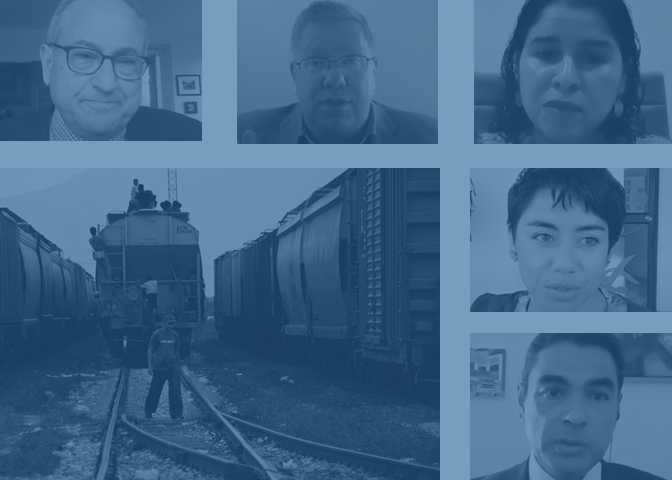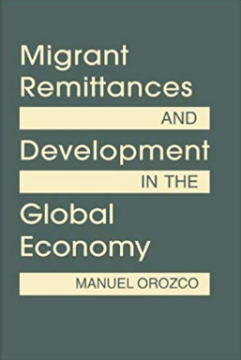The Earthquake’s Impact on Remittances
The earthquake in Haiti has exacerbated an existing distress during the international recession and increased uncertainty of what to do and how to help.
This post is also available in: Español
On September 21st, 2021, The Inter-American Dialogue hosted a panel titled “The Changing Face of Migration in the Americas” to discuss the growing scale of migration in Latin America and the Caribbean and the changing composition of these flows over the past two years.
The panel was moderated by Michael Shifter, Dialogue president, and featured speakers Carolina Jiménez Sandoval, president of the Washington Office on Latin America, Daniela Celleri, associate researcher at the Department of Sociology at Leibniz Hannover University, Andrew Selee, president of the Migration Policy Institute, and Manuel Orozco, director at the Center for Migration and Economic Stabilization and non-resident senior fellow at the Dialogue.
Selee emphasized that the increase in migration within the Americas is not a new trend but rather a continuation of migration trends from the past decade. However, Selee and Orozco both noted that migrants are now increasingly moving to the United States rather than to previous destination nations like Peru, Ecuador, Panama, and Costa Rica. Selee pointed to a continually limited workforce, increased systemic violence, and more frequent natural disasters as factors leading migration to rise, as well as pressure from the pandemic.
Outside of the U.S. border, Jiménez Sandoval emphasized the importance of communities of origin and transition countries, particularly for Venezuelan refugees arriving in the neighboring state of Colombia. She highlighted that Haitian migrants and Venezuelan migrants face particularly pressing humanitarian crises, and these groups of migrants should be considered protected peoples under international law. She stated that countries must respond to the influx of migrants through this lens and careful and systematic protection of their human rights.
Celleri offered perspectives on the dual trend of increased immigration and emigration in Ecuador. An influx of Venezuelan refugees, caused by continually increasing push factors like political upheaval and food insecurity, has grown the rate of migrant arrivals in the nation. Out-migration from Ecuador, conversely, may be attributed to economic issues, labor market conditions, and heightened unemployment rates. In light of these diverging trends, she welcomed the growing discussion of integration and inclusion policies in Ecuador that can support immigrants and those migrating outside Ecuador as well.
Orozco attributed the changing face of migration to increased economic pressures, bubbling socioeconomic violence, and worsened health conditions as a result of the pandemic. He pointed to “vaccine migration”, and countries like Guatemala, Nicaragua, Haiti, and Cuba that have suffered disproportionately from the health effects of the pandemic have seen more people leave their nations. For Nicaragua and El Salvador, increased government tensions and pressures from 2019, exacerbated by the pandemic, have led migration to increase and maintain high levels into 2021. He likened these trends to a bubble burst, wherein building pressures that were previously tempered by the pandemic have risen to the surface and are driving migrants to leave. Data can be found in Orozco's report here.
The panelists concluded by offering their thoughts on the future of migration policies and protection systems in the Americas. Jiménez Sandoval and Selee agree that there is an ineffective and underwhelming response to increased migration from the Biden administration as the result of a lack of significant and robust immigrant infrastructure at the border.
Selee emphasized the need for permanent measures, particularly ones that aim to manage migration rather than stop it. He noted that the “root causes” approach, which aims to de-incentivize migration through the economic and social development of communities of origin, is an effective strategy to manage migration. But, he cautioned, we must not be illusioned in thinking of the roots approach as a short-term method that will immediately slow or stop migration.
Celleri cemented the importance of inclusion policies in areas where people are both leaving and arriving. Inclusion policies, she said, must incorporate arriving refugees and migrants into the labor force and social life of their host communities. More accessible legal pathways, workforce inclusion, and the reduction of xenophobia are critical to creating an effective and robust migration management system.
Orozco concurred that the issue of migration needs to be addressed through integration, and, like Selee, particularly noted the importance of an inclusion strategy in which migrants can access the full economic potential of their host communities. He underlined the potential of remittances as an economic stability strategy that may be leveraged to generate wealth and reduce migration from communities of origin.
Jiménez Sandoval advocated for building better regional protection systems over the now favored regional policing systems in light of a rapidly changing migration demographic. She pointed to the new Colombian inclusion policies that aim to integrate Venezuelan migrants as an example of rising migrant protection systems but warned that a strategy like Colombia’s cannot work for every country and emphasized the need for a coordinated regional approach. Like Selee, she acknowledged that a protection system is not short-term and will be difficult without political consistency and attention. Otherwise, she cautioned, it is possible to lose sight of the goals of a stable, effective, and long-term migration management system.
The earthquake in Haiti has exacerbated an existing distress during the international recession and increased uncertainty of what to do and how to help.
This month the two most important political events occurred in Cuba since Raúl Castro became president four years ago – the announcement of plans to release 52 political prisoners and Fidel Castro’s first major public address since he fell ill in late 2006.
How do patterns of migration and remittances differ across regions? What kinds of frameworks support the contributions of remittances to local development?
 Main photo: Peter Haden / Flickr / CC by NC 2.0
Main photo: Peter Haden / Flickr / CC by NC 2.0
